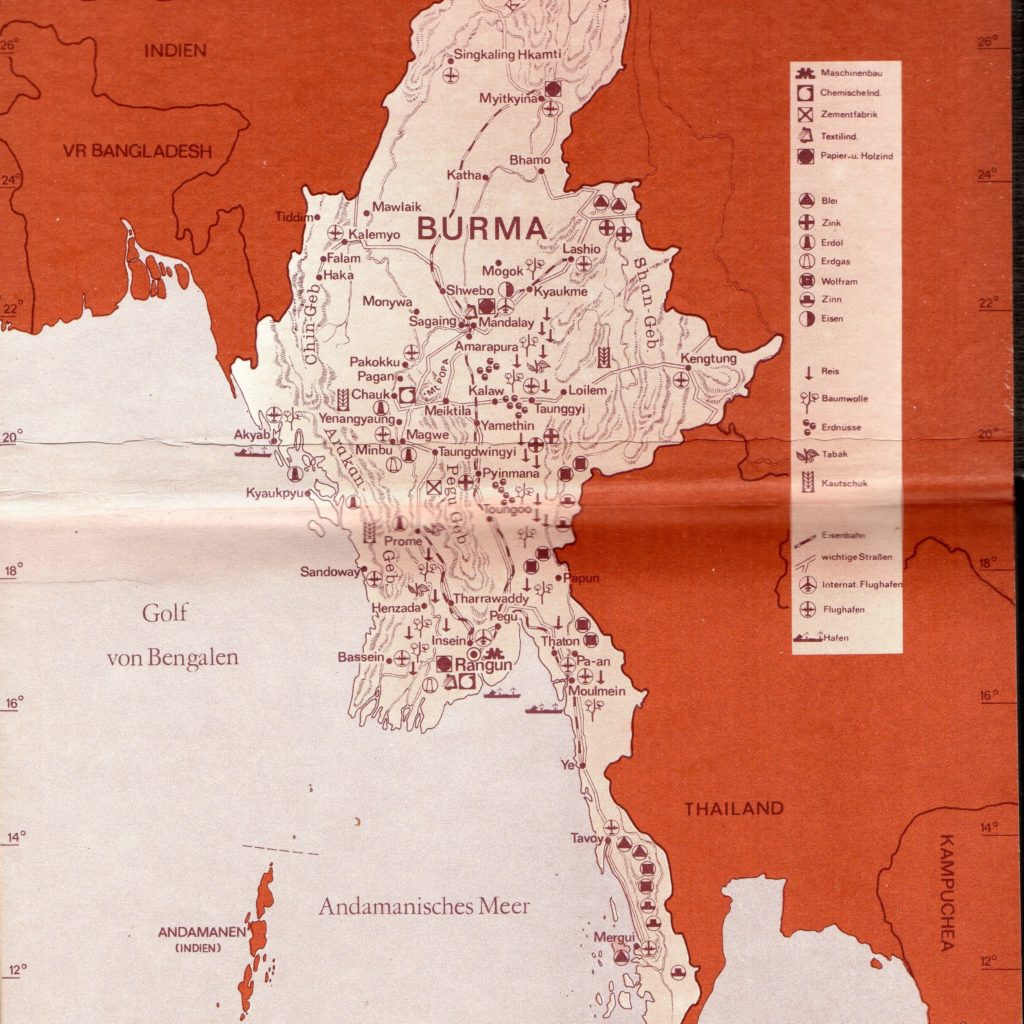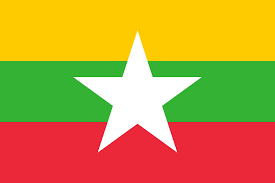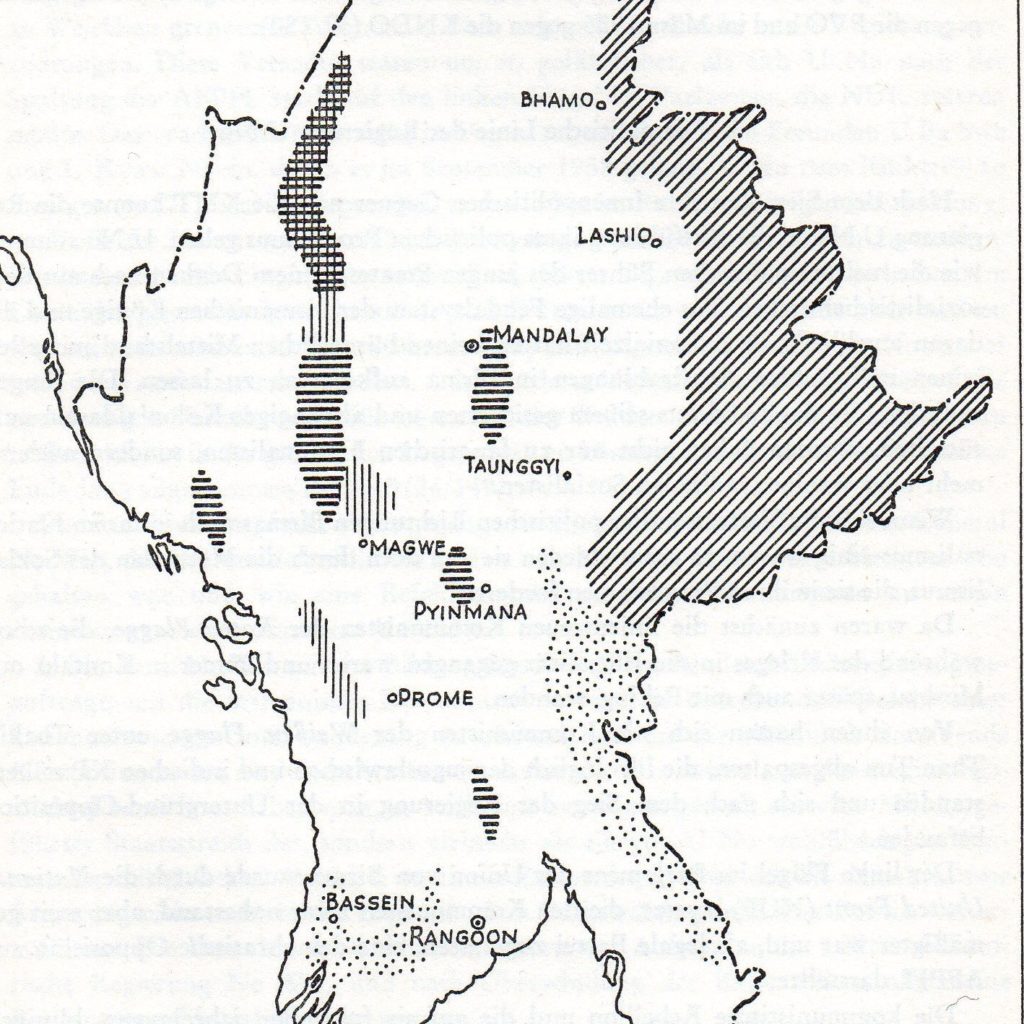Burma - The country and its people

Burma a.k.a. Myanmar (as it has been officially called since 1989) covers an area of more than 676,000 square kilometers, almost three times the size of the United Kingdom. It extends between the 28th and 10th degrees north and the 92nd to 100th degrees east. It borders on India and Bangladesh in the west, China in the north and Laos and Thailand in the east. Myanmar has a great variety of landscapes, ranging from the glaciers of the Himalayas to dry savannas in the central plain to tropical jungles in the south. The country has around 54 million inhabitants, two thirds of them ethnic Bamar, who also gave it its name. The rest is made up of more than 120 ethnic groups, some quite numerous (Shan = 9% of the population), others only comprise a few thousand people.
About nine out of ten residents are Buddhists, the rest are Christians, Muslims and Hindus. Animism as well as astrology still play a major role, almost the entire population is superstitious. Even foreigners are affected. The largest city in the country is the former capital Yangon with almost 6 million inhabitants, i. e. about twice as many as Berlin. The capital Naypyidaw was only founded in 2005 and has less than 100,000 inhabitants. The history of the country goes back to pre-Christian times. Great empires (the most famous of them was the Bagan Empire (1144-1287) and small states alternated. In the mid-19th century Burma became a British colony and the aftermath of that period (divide and rule!) can still be felt today. Since independence (1948) civil wars have continued to the present day. The democratically elected government of U Nu was swept away by a military coup led by General Ne Win in 1962. It resulted in almost fifty years of military dictatorship in which the country was largely isolated from the world. In 1988 there was a popular uprising in Burma, which was suppressed by the military. Another military clique seized power and, as a first act, renamed the country by giving it back its old name. Free elections were promised and held in 1990. The result was a disaster for the Military Party and the ruling junta refused to acknowledge the outcome and the generals retained power in their hands. However, they promised a cautious transition to democracy. But only after a new constitution had been drawn up. This was finished in 2007 and approved by a large majority in a referendum in 2008. In 2010 there were the first democratic elections since 1990, which were boycotted by the leading opposition party (NLD). This party has been in power since 2015 under the leadership of the former ‘democracy icon’ Aung San Suu Kyi, albeit severely restricted by the constitution, which favours the military.
Since my first visit to Myanmar (1977) I have developed a keen interest in the country. I was completely fascinated and had no greater desire than to live there one day. In 1996 my dream came true. Up until the 1990s it was difficult to get up-to-date information about Burma. In the world press it was viewed as a kind of bizarre fairy-tale land, albeit in a benevolent way. That changed after the popular uprising of 1988. The country – or better: its government – suddenly became the pariah of the international community. Boycotts and sanctions in the western world prompted Myanmar’s government to lean more and more on China. However, this resulted in an increasing dependence on the communist neighbor, which made the Myanmar government more and more concerned. As a result it started a policy of rapprochement towards the western powers. In my opinion, the democratization of the country was an attempt to create a counterweight to China. However, suddenly the international press was full of articles about Myanmar. Unfortunately always negative, as the journalistic diligence often fell by the wayside. Topics such as forced labor, child soldiers, serious human rights violations, lust for nuclear power, axis of evil, etc. dominated the headlines. Based on my experiences in Myanmar, I wonder whether this is an isolated case. Why should reports e.g. from Paraguay or Mozambique be more truthful than those from Myanmar, which I happen to know quite well?
Things often don’t look much better in the field of literature. In my opinion, many authors do not regard the Burmese as equal, adult human beings. But rather as vulnerable children who are or have been terrorized by a brutal military regime. Hence the commitment with which many of them get excited about the military government and the conditions in the country. Emma LARKIN stands out among these authors. Others are not far behind her either. In my opinion, this is based on an infantilization of the Burmese, who are supposedly unable to defend their interests themselves. They absolutely need the help of (often well-paid) outsiders. In booklets like Do’s and Don’ts in Myanmar it is pointed out in all seriousness that adults (and of course also children) must not be stroked on the head! Who would come up with such an idea? Only a person who does not take his counterpart seriously! How stupid do you think the tourists are for whom this was written? Why not point out that males shouldn’t walk the streets with their pants down?



Although the government has managed to resolve many internal conflicts, clashes between the Burmese military and various ‘liberation movements’ still occur nowadays. I think there is a simple reason for this instability. Sometimes it seems to me that everyone in this country who has the feeling that something doesn’t suit him is founding his own ‘liberation front’. He gets himself some weapons, recruits a few disgruntled people from his ethnic group and starts a little private war. There were times when more than sixty (!) such movements were operating in the country simultaneously. Not infrequently cheered (and supported!) by ‘well-meaning’ people from the West! What can be wrong when people are fighting for their freedom? The same people also like to turn a blind eye when the ‘war of liberation’ is financed by drug trafficking. Which was more the rule than the exception.
Apart from that, Myanmar is an incredibly beautiful country and its residents are the nicest people I’ve met in my life. Even after living here for twenty-five years, nothing has changed in my positive assessment. Conclusion: Myanmar is an absolute MUST!
I have recorded my experiences in Myanmar and my assessment of the country in the (unpublished) book ‘Forty Years in Burma’. Excerpts can be found on this website.